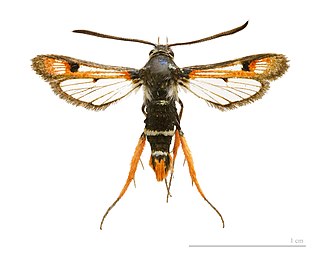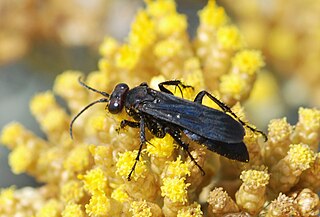
Sesioidea is the superfamily currently containing clearwing moths (Sesiidae), castniid moths (Castniidae) and little bear moths (Brachodidae). There is evidence from head and thoracic morphology that the first two families, internally feeding in plants as caterpillars, are sisters, whilst some brachodids are known to feed on leaf surfaces. Sesioidea are considered to be the sister group of Cossoidea which contain the also internal-feeding Goat and Leopard moths.

Cossoidea is the superfamily of moths that includes carpenter moths and relatives. Like their likely sister group Sesioidea they are internal feeders and have spiny pupae with moveable segments to allow them to extrude out of their exit holes in stems and trunks during emergence of the adult.
Andesiana is a genus representing its own family Andesianidae and superfamily Andesianoidea, the "Andean endemic moths". It contains three species with a wingspan up to 5.4 cm. in female A. similis and 3.5 cm. in males. This far surpasses in size any previously known monotrysian moth. These large Microlepidoptera are restricted to Andean South America, from where they were described originally in 1989 in the family Cossidae by their discoverer Patricia Gentili.
Cimeliidae, the gold moths, is a family of moths that is now placed in the macroheteroceran superfamily Drepanoidea, although previously placed in its own superfamily. Uniquely, they have a pair of pocket-like organs on the seventh abdominal spiracle of the adult moth which are only possibly sound receptive organs. They are quite large and brightly coloured moths that occur in southern Europe and feed on species of Euphorbia. Sometimes they are attracted to light. The family was first described by Pierre Chrétien in 1916.

Spiders are air-breathing arthropods that have eight legs, chelicerae with fangs generally able to inject venom, and spinnerets that extrude silk. They are the largest order of arachnids and rank seventh in total species diversity among all orders of organisms. Spiders are found worldwide on every continent except for Antarctica, and have become established in nearly every habitat with the exceptions of air and sea colonization. As of July 2019, at least 48,200 spider species, and 120 families have been recorded by taxonomists. However, there has been dissension within the scientific community as to how all these families should be classified, as evidenced by the over 20 different classifications that have been proposed since 1900.

Blatačko Lake is a natural lake 21 kilometers to the north-east of Konjic, in Konjic municipality, Bosnia and Herzegovina. The lake is a central feature of the natural & cultural-historical ensemble - cultural landscape - designated as National Monument of Bosnia and Herzegovina.

Agenioideus is a genus of spider wasps from the subfamily Pompilinae; the genus occurs in Europe, where 21 species are recorded, eastwards to Japan, in North America, South America, and Australia.

Euryopis is a genus of comb-footed spiders that was first described by Anton Menge in 1868.

The northern goshawk is a medium-large raptor in the family Accipitridae, which also includes other extant diurnal raptors, such as eagles, buzzards and harriers. As a species in the genus Accipiter, the goshawk is often considered a "true hawk". The scientific name is Latin; Accipiter is "hawk", from accipere, "to grasp", and gentilis is "noble" or "gentle" because in the Middle Ages only the nobility were permitted to fly goshawks for falconry.
Procopius is a genus of African corinnid sac spiders first described by Tamerlan Thorell in 1899.

Coscinida is a genus of comb-footed spiders that was first described by Eugène Louis Simon in 1895.
Coscinida novemnotata, is a species of spider of the genus Coscinida. It is endemic to Sri Lanka.
Coscinida triangulifera, is a species of spider of the genus Coscinida. It is found only in Sri Lanka and Java.
Nanometa is a monotypic genus of Western Australian long-jawed orb-weavers containing the single species, Nanometa gentilis. It was first described by Eugène Louis Simon based on a female found in 1908. It is included in a clade of its own defined by nine morphological synapomorphies, along with Eryciniolia and Orsinome.
Agalenocosa is a genus of spiders in the family Lycosidae. It was first described in 1944 by Mello-Leitão. As of 2017, it contains 18 species with a wide distribution.

Grammonota is a genus of dwarf spiders that was first described by James Henry Emerton in 1882.
Maorineta is a genus of dwarf spiders that was first described by Alfred Frank Millidge in 1988.
Satilatlas is a genus of sheet weavers that was first described by Eugen von Keyserling in 1886.
Grammonota gentilis is a species of dwarf spider in the family Linyphiidae. It is found in North America.
Hipposideros atrox, commonly known as the lesser bicolored leaf-nosed bat, is a species of bat found in Southeast Asia. Originally described as a subspecies in 1918, it was recognized as a full species in 2010. It uses echolocation to navigate and find prey, and roosts in caves during the day.








